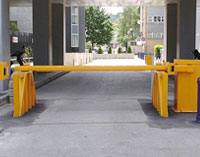Benefits Of Protection Barriers
Barriers Can Keep Parking Lots Secure
Protection barriers can be used to control access to an entire parking lot. They can also be used to secure individual parking spaces. The types of barriers that are used in parking lots are:
- Winged barriers that bend over
- Folding barriers that can be lowered down
- Telescopic barriers that retract back into the ground
All three types of these protection barriers work in a similar manner. For example, a parking lot owner may use winged protection barriers to protect reserved parking spots. When a spot is empty, the winged barrier can be put in its upright position. This will prevent any other cars from driving into the space. If the driver who reserved the spot needs to park, the barrier can easily be bent over.
Because the top of the barrier will be against the ground and the base will be in the middle of the parking spot, the driver will have no problem pulling into the spot. An added benefit of barriers that other options for reserving parking spots don't offer is if a driver parks their vehicle in its reserved spot and is concerned about the vehicle’s safety, the winged barrier can easily be lifted back up to keep the vehicle completely secure for the entire time it’s parked.
Protection Barriers Can Reduce Workplace Accidents
Multiple types of protection barriers can be used to make industrial settings safer environments. Wall buffers are one type of barrier that are specifically designed for industrial settings. This type of barrier will protect walls from being damaged if they are hit by an object. Not only is this type of protective barrier useful, but it's also very easy to install. Protection bars are another type of barrier that are specifically designed to be used in industrial settings. These bars can drastically reduce the odds of an accident involving a roller container or lift truck.
Roads and Sidewalks That Use Barriers are Safer
Protection barriers can do a lot to keep both drivers and pedestrians safe. On roads, barriers can be used to give drivers advanced noticed of potential hazards. Whether it's a road that takes a sudden turn or an area of the road that may be especially dangerous when the weather is bad, the height and reflective additions to barriers' surface will catch drivers' attention. Once a driver sees a group of barriers, they instantly know that they need to pay close attention to what's happening on the road.
One common concern about protection barriers used on the road is what if a driver hits one. Although this does not happen frequently, barriers are actually specifically designed for this situation. Depending on the type of protective barrier, it will either bend over upon impact and then return to its standard position or have features that minimize the amount of damage that is caused. For barriers that are used around sidewalks, not only will they keep pedestrians safe, but they will also make the area look quite nice.

